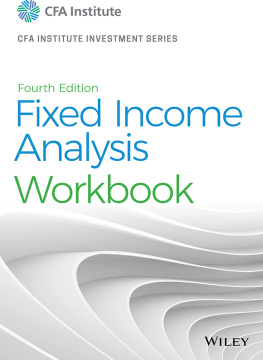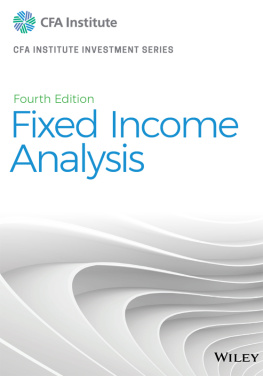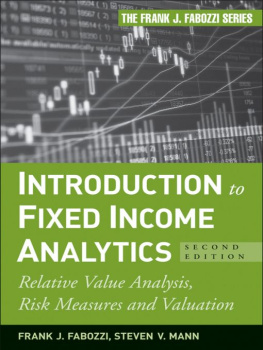Here is a chapter from The Handbook of Fixed Income Securities, Seventh Edition, which equips you with a comprehensive overview of all fixed income securities and strategies and continues to be the investment industrys most accessible and all-inclusive resource.

Copyright 2005, 2001, 1997, 1995, 1991, 1987, 1983 by The McGraw-Hill Companies, Inc. All rights reserved. Except as permitted under the United States Copyright Act of 1976, no part of this publication may be reproduced or distributed in any form or by any means, or stored in a database or retrieval system, without the prior written permission of the publisher.
ISBN: 978-0-07-171546-1
MHID: 0-07-171546-0
The material in this eBook also appears in the print version of this title: ISBN: 978-0-07-144099-8, MHID: 0-07-144099-2.
All trademarks are trademarks of their respective owners. Rather than put a trademark symbol after every occurrence of a trademarked name, we use names in an editorial fashion only, and to the benefit of the trademark owner, with no intention of infringement of the trademark. Where such designations appear in this book, they have been printed with initial caps.
McGraw-Hill eBooks are available at special quantity discounts to use as premiums and sales promotions, or for use in corporate training programs. To contact a representative please email us at bulksales@mcgraw-hill.com.
TERMS OF USE
This is a copyrighted work and The McGraw-Hill Companies, Inc. (McGraw-Hill) and its licensors reserve all rights in and to the work. Use of this work is subject to these terms. Except as permitted under the Copyright Act of 1976 and the right to store and retrieve one copy of the work, you may not decompile, disassemble, reverse engineer, reproduce, modify, create derivative works based upon, transmit, distribute, disseminate, sell, publish or sublicense the work or any part of it without McGraw-Hills prior consent. You may use the work for your own noncommercial and personal use; any other use of the work is strictly prohibited. Your right to use the work may be terminated if you fail to comply with these terms.
THE WORK IS PROVIDED AS IS. McGRAW-HILL AND ITS LICENSORS MAKE NO GUARANTEES OR WARRANTIES AS TO THE ACCURACY, ADEQUACY OR COMPLETENESS OF OR RESULTS TO BE OBTAINED FROM USING THE WORK, INCLUDING ANY INFORMATION THAT CAN BE ACCESSED THROUGH THE WORK VIA HYPERLINK OR OTHERWISE, AND EXPRESSLY DISCLAIM ANY WARRANTY, EXPRESS OR IMPLIED, INCLUDING BUT NOT LIMITED TO IMPLIED WARRANTIES OF MERCHANTABILITY OR FITNESS FOR A PARTICULAR PURPOSE. McGraw-Hill and its licensors do not warrant or guarantee that the functions contained in the work will meet your requirements or that its operation will be uninterrupted or error free. Neither McGraw-Hill nor its licensors shall be liable to you or anyone else for any inaccuracy, error or omission, regardless of cause, in the work or for any damages resulting therefrom. McGraw-Hill has no responsibility for the content of any information accessed through the work. Under no circumstances shall McGraw-Hill and/or its licensors be liable for any indirect, incidental, special, punitive, consequential or similar damages that result from the use of or inability to use the work, even if any of them has been advised of the possibility of such damages. This limitation of liability shall apply to any claim or cause whatsoever whether such claim or cause arises in contract, tort or otherwise.
CHAPTER
FORTY-SIX
GLOBAL CREDIT BOND PORTFOLIO MANAGEMENT
JACK MALVEY, CFA
Managing Director
Lehman Brothers
Corporate bonds are the second oldest and, for most asset managers, the most demanding and fascinating subset of the global debt capital markets. The label, corporate, understates the scope of this burgeoning asset class. As commonly traded and administered within the context of an overall debt portfolio, the corporate asset class actually encompasses much more than pure corporate entities. Instead of the title, corporate asset class, This segment of the global bond market really should be classified as the credit asset class, including any nonagency mortgage-backed securities (MBS), commercial mortgage-backed securities (CMBS), and asset-backed securities (ABS). Sovereigns and government-controlled entities with foreign currency debt issues thought to have more credit risk than the national government also should be included. In keeping with conventional practice in the fixed income market, however, the application of the term credit asset class in this chapter will pertain only to corporate bonds, sovereigns, and government-controlled entities.
From six continents, thousands of organizations (corporations, government agencies, projects, and structured pools of debt securities) with different credit stories have sold debt to sustain their operations and to finance their expansion. These borrowers use dozens of different types of debt instruments (first mortgage bonds, debentures, equipment trust certificates, subordinated debentures, medium-term notes, floating-rate notes, private placements, preferred stock) and in multiple currencies (dollars, yen, euros, Swiss francs, pounds) from maturities ranging from one year to even a thousand years. Sometimes these debt structures carry embedded options, which may allow for full or partial redemption prior to maturity at the option of either the borrower or the investor. Sometimes the coupon payment floats with short-term interest rates or resets to a higher rate after a fixed interval or a credit-rating change.
This chapter is adapted from Relative-Value Methodologies for Global Credit Bond Portfolio Management, Chapter 5 in Frank J. Fabozzi (ed.), Fixed Income Readings for the Chartered Financial Analyst Program (New Hope, PA: Frank J. Fabozzi Associates, 2004).
further underscores the oscillations in relative credit performance.
Global credit portfolio management presents a complex challenge. Each day hundreds of credit portfolio managers face thousands of choices in the primary (new issue) and secondary markets. In addition to tracking primary and secondary flows, investors have to keep tabs on ever-varying issuer fundamentals, creditworthiness, acquisitions, earnings, ratings, etc. The task of global credit portfolio management is to process all this rapidly changing information about the credit markets (issuers, issues, dealers, and competing managers) and to construct the portfolio with the best return for a given risk tolerance. This discipline combines the qualitative tools of equity analysis with the quantitative precision of fixed income analysis.
illustrates the magnitude of this information-processing challenge. From a set of 5,000 different issuers, investors can assemble 4 10 (55) different combinations of 20-bond portfolios. The number of potential portfolio combinations of 20 bonds expands to the infinity neighborhood with the inclusion of additional variables such as rating (20 choices), issues (100,000), and currencies (at least 20). Incredibly, the number of potential combinations of this 20-bond credit portfolio exceeds the neutrons in the known universe. In turn, this begs the question of whether credit portfolio optimization is truly achievable given the current state of technology. Although perfect optimization may prove elusive, the optimization goal remains a worthy pursuit for asset managers.
Despite this apparent limitation on the perfection of corporate portfolio optimization, broad demand exists for corporate debt. Investors in corporate debt consist of individuals in the pursuit of high yields, central banks aiming to extract a higher yield and return on their considerable holdings of fixed income assets, commercial banks arbitraging the difference between the higher yields on floating-rate notes and their lower cost of funding, mutual funds attempting to maximize both yield and total return, insurers and state pension funds seeking to fund their projected long-term liabilities, pure Total-return maximizers competing against each other on a monthly, quarterly, and annual basis to satisfy their clients (public or private pension fund plan sponsors) or risk their loss, and hedge funds staking out leveraged long or short positions in credits with short-term potential for major spread movements. Portfolio investment choices are driven also by the existing security population of the corporate market (sector, issuer, structure, and currency), by the psychology of the portfolio managers (overall risk tolerance, shortfall risk aversion, and internal politics of the investment-management institution), and the state of market liquidity.
Next page





